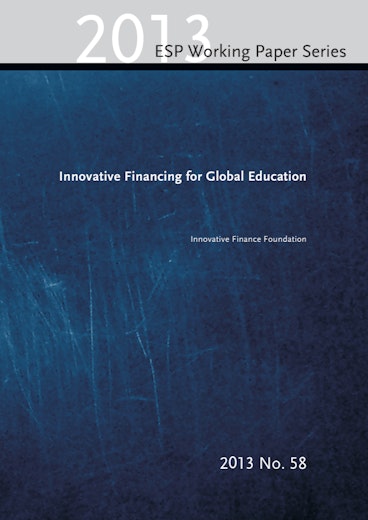A Fresh Approach to Education Funding
By Aleesha Taylor
Around the world, access to education has dramatically increased over the past decade. Yet at least 57 million children remain out of school, and 250 million who are currently enrolled are not learning at grade level.
Despite this crisis, aid commitments to education are declining at an alarming rate. The funding gap for achieving quality basic education is estimated at $26 billion, not including pre-primary and secondary education.
Innovative financing is one promising way to reduce that gap.
What is “innovative financing”?
“Innovative financing” refers to ways of generating public and private funding that will augment traditional forms of international aid (such as donor funds) for global public goods such as education, health, and addressing climate change. This form of financing can create fresh streams of revenue through bond issuances, taxation (for example, proposed levies on airline tickets and financial transactions), public-private partnerships, and new approaches to increasing existing resources (such as debt buy-downs and commitment of future revenues from natural resources).
Why do we need innovative financing for education?
The international community has acknowledged that traditional approaches to financing are insufficient to fill the gap in achieving quality basic education. That’s where innovative financing can help, as it has in the health sector.
For example, UNITAID, a global health initiative established by the governments of Brazil, Chile, France, Norway, and the United Kingdom, has raised over $2.5 billion for health projects worldwide through an airline ticket levy collected in several UNITAID member countries. The health sector has also benefited from the International Finance Facility for Immunization, a public-private partnership that has generated $4.5 billion for vaccines by issuing bonds against donor pledges.
What lessons can be learned from innovative financing in other sectors?
As demonstrated in other sectors, innovative financing can accomplish a variety of objectives. It can be used to mobilize financing (such as taxation or bond issuances) and to raise the visibility of a sector or a priority within a sector (for example the RED campaign, which raises funds for and awareness of HIV and AIDS). Innovative financing can also engage a broader range of partners and target resources to scale specific interventions (for example mobile technology).
These experiences are all applicable to the education sector, where innovative financing could be used to raise the profile of education or a specific priority such as girls’ or early childhood education. It could also be used to promote innovation by harnessing experiences from the private sector that can increase the efficiency of school construction or the delivery of materials to classrooms.
How are the Open Society Foundations supporting innovative financing development?
Since 2010, the Open Society Education Support Program has been shaping the debate on innovative financing for education and exploring potential mechanisms (such as debt conversion development bonds) for improving the availability of resources for public education. We have supported the work of the Leading Group on Innovative Financing for Development’s Education Task Force, a convening of 64 countries and 38 international organizations.
We engage partners such as the Innovative Finance Foundation, Results for Development Institute, and D. Capital Partners to advance the discussion and assess the feasibility of prospective financing instruments. We support research at the global level and in the developing world, and build the skills of education and finance practitioners through a summer program at Central European University and workshops in southern Africa.
We have worked closely with the Global Partnership for Education, a multilateral group that has channelled over $3 billion of aid to support developing countries in building quality education systems. The partnership is exploring ways to leverage bilateral contributions to buy down developing country debt, enabling governments to commit more funding to the education sector.
Until October 2016, Aleesha Taylor was deputy director of the Open Society Education Support Program.
